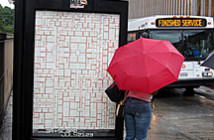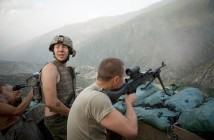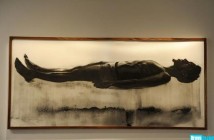 |
|
| CLICK FOR IMAGES FROM THE HOMESTEAD AK |
This July, I had the opportunity to travel to Alaska and spend some time at the Homestead AK, a residency for artists interested in experiential art making, exploration of site, and daily co-habitation.
Located in Sunshine, Alaska, about an hour north of Wasilla, and two hours south of Denali, the Homestead sits on roughly 80 acres of land, bound by a highway and great valley. Among forests and bogs of mossy green — lay fields of dandelion, grass, and fireweed, laced with ants and bees. Bear, moose, and fox are some of the animals present, and yet, often out of view.
Welcome to the world of man versus mosquito, endless dusk and dawn, late-night card playing, big box grocery shopping, and the great salmon run. Time stretches by the day — moving hours forward, through and backward — with extra minutes in between... leaving plenty of time for meals, conversations, and campfires to shift under the influence of daydreams. Punctuated by coffee, PBR and sleep.
At the mouth of a long, dirt driveway, a California-style ranch house, wooden sheds and pick-up trucks define an area of influence — extended into the wilderness through the presence of metal objects lost and found. A depository of things whose history, function and value are in question, the area exists as a monument to man's will. Giant metal barrels, old missile casings, car hoods, washing machines, beach chairs, bicycles, gears, and mattress springs sit stacked, folded, and heaped in piles.
In the upper field, 25 cars sit parked on either side of an invisible lane. Reminiscent of their owners, passengers, and the places they once went: Mercedes, Volkswagon, Volvo, Nissan, Ford, Chevrolet.
Standing on the roof of a 1970's Pontiac — looking out to the forest, beyond bushes, tall grasses and trees, I attempt to escape my thoughts of usefulness and uselessness, mobility and the machine — the production of identity, roles, and mechanical things. (What does it mean to go back to the land, to then create what you need?) Despite my hesitancy to accept their being as part of the natural landscape, the cars sit relatively rust-free. Doors unlocked, they are packed like closets, with bags, boxes, lawn mowers, hubcaps, tires, and tools.
The Homestead AK was acquired in the early 1960's as part of the Homestead Act of 1862. First claimed by a California developer, the property was then purchased by Chuck Chaney's family. Chuck is a multidisciplinary artist who received his MFA from theSchool of the Museum of Fine Arts, Boston, and is the Director of the Homestead AK residency program. He was born in Alaska and lived at the Homestead for the first 5 years of his life — playing in a grove of trees with a cluster of boulders as his playground.
Chuck's father lived on the land until recently, collecting the objects and vehicles we now know as the Homestead. There is a survivalist aesthetic to what's there, to how things are arranged, put together, and made to function, reflecting his interests, toolings, and what he may have come to need in the near or distant future. Things pile up, and moss grows. An unopened package of rain ponchos sits next to a box of spray paint in the woods. A collection of pop psychology literature stands on a bookshelf in the living room, along with "Jonathan Livingston Seagull," and a range of "How To."
We usually wake up around noon at the residency, after acclimating to Alaskan time. Someone lights the stove to make coffee. Others move slowly to rise. There is often rain, then sun in the afternoon. On good days, there's sun at the start. I like to sit at the picnic table with my notebook, and stand by the old Chevy pick-up with my mug, drawing in the sun's rays to heat up.
Morning becomes afternoon, walking up and down the fields, to the bog, around the junk, and to the highway. With thick woods full of unseen beasts, I stay well within yelling distance, with an eye for being in sight; listening newly to whatever may be nearby, while thinking about my markings and the sounds I make as I move. I'd really like to learn what it means to be Alaskan. Walking to the nearest store where I can buy something seems to be the best way to try. Accents drift in and out, and people seem polite. I notice people often wear boots, and that ice cream and booze are readily available.
Off to the "Tackle Cache," a store at the local campsite, located down the road. Faith Johnson, Lauren Payne, and I walk along a four-wheeler path parallel to the highway. It's our outing of the day, and takes about 20 minutes in one direction. With coffee by donation and free checkers outside at the picnic table, you can sit for hours and no one really cares, let alone notices. There's really no traffic at all. An occasional truck or RV will pull into the parking lot, comment on our game, and move on. I learned from the women working at the "Tackle Cache" how to get from here to there and there to here, and that I really couldn't get anywhere without a vehicle.
Back at the homestead, dinners happen late. After snacks of peanut butter, cheese, oranges, and crackers, we eat well. Big meals of fresh salmon, caught by Richard Spartos and Chuck, cherry dressing, salad, and homemade mashed potatoes. Chuck is quite the chef. There's a wall that's a blackboard in the dining room that serves to mediate conversation. Yes and No words, phrases, and plans — lend themselves to laughter, group humor, and a healthy sense of being.
Sometimes there are fires in the fire pit out back, with beer, stars, and a light sky. And then, hours in "Metal Alley": fine-tuning radiator tubes, car hoods, barrels, casings and sheets of steel to make sounds by kicking, scratching, and gliding objects over their surfaces. With the use of feet, shovels, strings, vents and cans; humming, yelling, and intonations of word speak — the metal objects resonate. It is both a singular and collective sounding, to who, to what, is not known, and yet powerful as an assertive question.
Then, sleep. Sometimes I hear voices in the garage below my room, and rain on the roof like a banging can.
There is a large wooden building next to the house that is a group studio. Its walls are lined with shelves, boxes, and miscellaneous things. Along one side of the room, there's a long plywood table, a round card table, and a 1950's chrome-plated dining table for everyone to share. Chaos becomes order as each artist prepares objects and items to be carried outside, as props, backdrops and elements in performance, installation, and gestural works. The residency encourages the creative use and re-use of materials at hand, while challenging artists to intuitively and conceptually respond to the site and their experience thereof. Many of the works made by artists who have attended the Homestead AK are immaterial and ephemeral — existing as photographic, sonic, and written documentation of events, moments, and actions.
Covered in Deet, I carry my Passive Visual Warning paper piece out into the field. Arms up like a Y, I try to keep the 5' x 7' pattern outstretched and visibly defined as a motif. Moving away from the building through tall, wet grasses, fireweed, and bushes, I define my movements, limits, and boundaries, while making my presence clear. It is an act of strength, and hidden weakness. I originally thought the meaning of the piece would be evident in the geometry, colors, and references to caution symbols in contemporary culture — transposed within a rural environment. I did not account for what it would be like to use and activate the sign as a performance, using my own determination as content, physically initiating a dialogue with my surroundings. The work is a self-reflective reaction to unfamiliar conditions, involving animals, wilderness, and nature.
I begin to play with a found shovel and car hood in Metal Alley each day. Holding the wooden handle of the shovel with two hands, I wield the steel blade up and down the car hood's spine, in repetitive but varied applications of pressure and duration. I think I've found my chosen tool. How can I attempt to learn how to use these things anew? I'm quoting their formal properties, while synthesizing my presence through the process. (Jennifer Schmidt, Shovel On A Car Hood: Concert for Sand Hill Cranes, 2010)
The other artists at the residency inspire me to think in this way. Most have a creative background in performance and compose situations and sequences of behavioral response as a means of making work. In many ways, their material is time, drawing on call and response, participation, and the inherent qualities of things.
Special thanks to gasoline, electricity and fire.
Images courtesy of Lauren Payne, Chuck Chaney, Richard Spartos, Faith Johnson, Amy Carroll Reinthaler, and Jennifer Schmidt.



